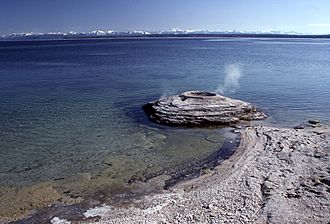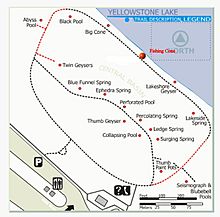Fishing Cone facts for kids
Quick facts for kids Fishing Cone |
|
|---|---|

Fishing Cone
|
|
| Location | West Thumb Geyser Basin, Yellowstone Lake, Yellowstone National Park, Teton County, Wyoming |
| Coordinates | 44°25′02″N 110°34′13″W / 44.4172652°N 110.5702776°W |
| Elevation | 7,736 feet (2,358 m) |
| Type | Cone geyser |
| Eruption height | 40 feet (12 m) |

West Thumb Geyser Basin
|
|
Fishing Cone is a unique hot spring located in the West Thumb Geyser Basin of Yellowstone National Park in the United States. It's a cone-shaped mound right on the edge of Yellowstone Lake in Teton County, Wyoming.
This natural wonder used to be a geyser, meaning it would erupt and shoot hot water high into the air. In the early 1900s, its eruptions could reach up to 40 feet (about 12 meters) tall! However, over time, the water level in Yellowstone Lake has risen. This means Fishing Cone is often covered by lake water, especially in the spring. The cooler lake water has also made the cone's temperature drop. Because of this, Fishing Cone no longer erupts and is now considered a hot spring.
The Story of Fishing Cone
The name "Fishing Cone" comes from some incredible stories told by early explorers and adventurers. These "mountain men" would share tales of a special spot on the lake. They claimed you could catch a fish from the cool lake water and then, without even taking it off your hook, dunk it right into the boiling hot spring water inside the cone to cook it!
A Famous Feat
This amazing trick became very popular after a member of the 1870 Washburn-Langford-Doane Expedition showed how it was done. This expedition was a group of explorers who helped map and describe the Yellowstone area. Their stories helped make Fishing Cone famous.
Why the Fishing Stopped
While the idea of catching and cooking a fish right away sounds interesting, it also raised concerns about animal welfare. In November 1911, a rule was announced to stop this practice. This ban officially started in early 1912. Today, visitors to Yellowstone National Park are not allowed to fish from Fishing Cone or try to cook fish in its hot water. This rule helps protect both the park's natural features and its wildlife.

